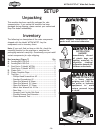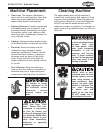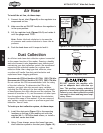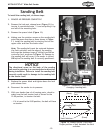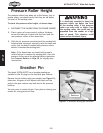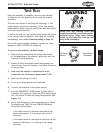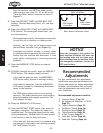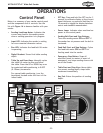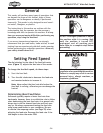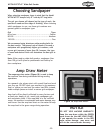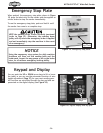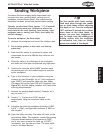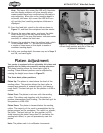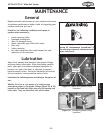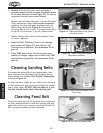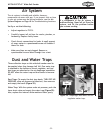
-24-
W1756/W1757 43" Wide-Belt Sander
OPERATIONS
General
This sander will perform many types of operations that
are beyond the scope of this manual. Many of these
operations can be dangerous or deadly if performed
incorrectly. This sander is only designed to sand wood—
not metal, fiberglass, or plastics.
The instructions in this section are written with the
understanding that the operator has the necessary
knowledge and skills to operate this machine. If at any
time you are experiencing difficulties performing any
operation, stop using the machine!
If you are an inexperienced operator, we strongly
recommend that you read books, trade articles, or seek
training from an experienced
wide-belt sander operator
before performing any unfamiliar operations. Above all,
your safety should come first!
DO NOT investigate problems or adjust
the machine while it is running. Wait
until the machine is turned OFF,
unplugged and all working parts
have come to a complete stop before
proceeding!
OFF
Always wear safety glasses and a
respirator when operating this machine.
Failure to comply may result in serious
personal injury, allergic reactions, or
respiratory problems.
Setting Feed Speed
The dial attached to the side of the feed belt motor
cover (Figure
17) adjusts the feed rate of the sander.
To change the feed belt speed, do these steps:
1. Start the feed belt.
2. Turn the dial clockwise to decrease the feed rate
and counterclockwise to increase it.
Note: Never adjust the feed rate dial unless the
feed belt is running, otherwise you can damage the
control.
Determining Ideal Feed Rates
Softwoods typically require a faster feed rate than
hardwoods; however, there is no definitive rule to follow
when determining the best feed rate. As a general rule,
always start with the slowest feed rate and work your
way up. We always recommend testing the feed rate
using scrap wood similar to your workpiece. Be sure
to monitor the amperage meter (see Page 25) when
adjusting the feed rate. Decrease the feed rate if the
load begins to slow the motor RPM.
Figure 17. Variable feed rate dial.



